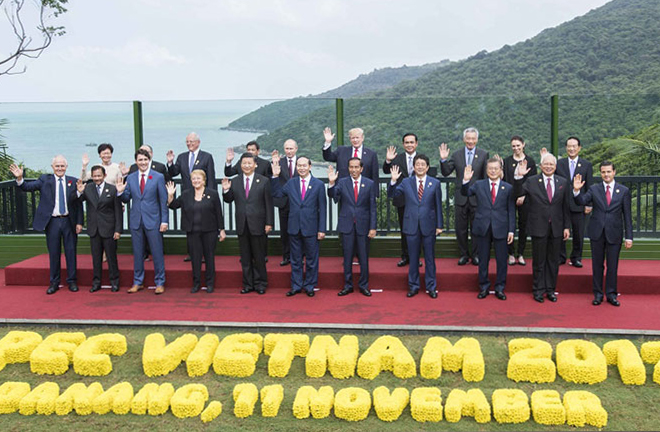China’s development presents new paths for Asia-Pacific, world

The Asia-Pacific Economic Cooperation (APEC) Economic Leaders' Meeting of 2017 was held on Nov. 10-11 in Da Nang, Vietnam.
Commenting on the 25th APEC Economic Leaders Meeting, which was held in the coastal city of Da Nang, Vietnam, on Nov. 11, scholars said that the development course of China can offer experiences that will help the Asia-Pacific region and the world as a whole regain growth momentum.
“The path of development has no end, but only new starting points,” said Xu Liping, a research fellow from the National Institute of International Strategy at the Chinese Academy of Social Sciences. While countries around the world are increasingly implementing protectionist policies, China is advocating economic globalization and trade liberalization, which can greatly benefit APEC, Xu said.
Innovation is the first lever to boost development. In recent years, the Chinese economy has adhered to the path of developing through innovation, nurturing new driving forces constantly.
Thirty years ago, the first e-mail of China was sent from Beijing. Now, internet users in the country number 750 million, the volume of online retail sales grows by 30 percent annually on average, the scale of sharing economy totals 3.5 trillion yuan, and that of mobile payment has exceeded 158 trillion yuan. High-speed rail, mobile payment, bike sharing and online shopping have been dubbed the “New Four Great Inventions” of China.
“Over the years, China, as a major developing country in the Asia-Pacific region, has carried out bold reforms, unleashing the vitality of the domestic economy and creating new drivers for growth,” Xu said, adding that the Asia-Pacific region needs bold reforms, too.
Noting that the world is undergoing profound changes in growth drivers, development models, economic globalization and global economic governance, Xu said that the Asia-Pacific region, as a major engine of world economic growth, should take actions based on the overall picture to usher in a new round of global prosperity.
Wang Yiwei, a professor from the School of International Studies at Renmin University of China, said that the Asia-Pacific region also needs to find sources of momentum and directions as economic globalization enters a new starting point.
China has led the way in deepening domestic reform, propelling economic restructuring and advancing the transition from outdated to new driving forces, Wang said.
“The rise of China is not only about the growth of the GDP and national strength, but more importantly, about promoting and initiating new ideas to make the international system and order fairer and more reasonable,” said Wang Fan, vice-president of China Foreign Affairs University (CFAU).
Wang Fan said China stands in sharp contrast to some exclusive Western developed countries because it stresses openness in proposals concerning the international system. Moreover, the country is vigorously performing its major-country responsibilities.
Wu Zhicheng, director of the Institute of Global Studies at Nankai University, said that China has been striving to be an advocate of peace, a contributor to development, a driver of cooperation and a builder of the community of common destiny for the Asia-Pacific region. Its sincerity in practice and substantive achievements have earned it recognition from the international community, particularly within the region.
Chinese responsibilities and solutions will simultaneously boost inclusive, innovation-driven growth domestically and at the Asia-Pacific level, said Chen Yugang, a professor from the School of International Relations and Public Affairs at Fudan University. The Asia-Pacific region can leverage the “Belt and Road” initiative and prioritize interconnectivity to achieve the goal, Chen said.
ZHANG JUNRONG is a reporter at the Chinese Social Sciences Today.
